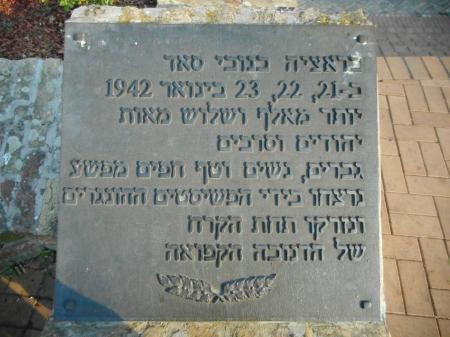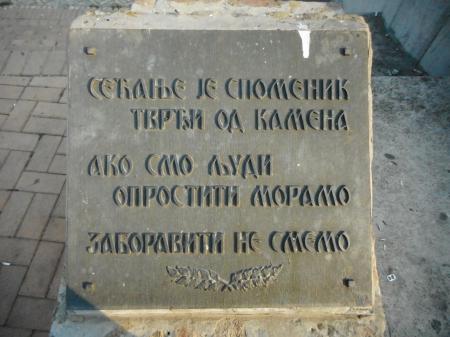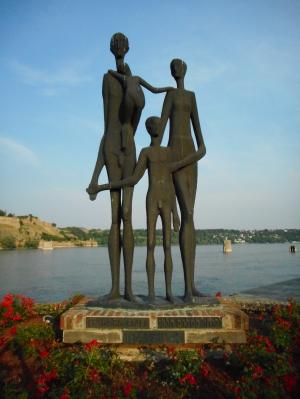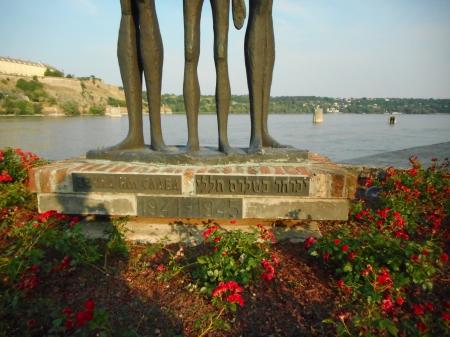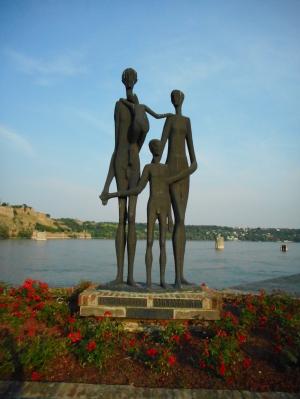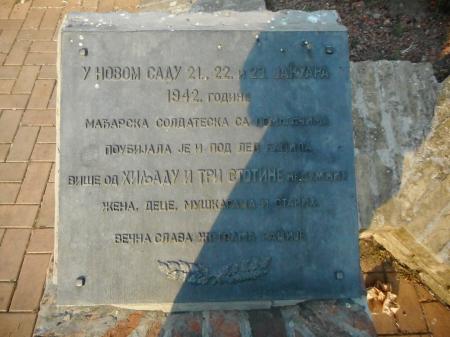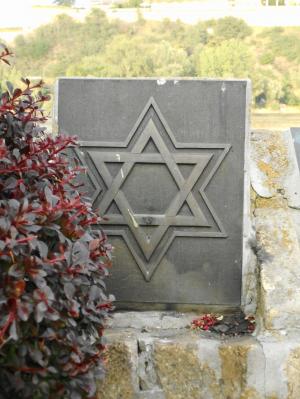Obj. ID: 50022
Modern Jewish Art "The Family" Holocaust Memorial in Novi Sad, Serbia, 1971

Memorial Name
The Family
Who is Commemorated?
Victims of the Razzia Pogrom (also known as The Novi Sad Raid of January 1942)
Description
The memorial is located on the bank of the Danube River incorporating elements of the embankment into its composition.
The four-meter-high bronze monument is composed of four figures - father, mother, and two children, compounded into one mass with their hands held together. The memorial is set on a brick base with commemorative inscriptions written on bronze plaques.
The monument was supplemented in 1992 with 78 bronze plates. Four plates carry inscriptions with basic information about the commemorated event; 3 plates in Serbo-Croatian, and 1 in Hebrew. Additional 66 plaques bear the names of the victims. They are divided by decorative plates employing symbols: Magen Davids (4 panels), Crosses (2), and Dharma Chakra or cartwheels (1). These plaques are installed on the brick embankment.
Inscriptions
The 1971 Inscriptions
On the base of the monument
Serbo-Croatian
Вечна им слава
Translation: Eternal glory to them
Hebrew
ינוחו בשלום חללי
Translation: May the martyrs rest in peace
1941-1945
Below the base of the monument (identical inscriptions)
Serbian
Žrtvama fašizma
Croatian
Жртвама фашизма
Hungarian
A fasizmus áldozatainak
Slovak
Obetiam fašizmu
Translation: To the victims of fascism
The 1992 Inscriptions
Plaque 1 (Serbo-Croatian)
У Јужној Бачкој јануара 1942. године спроводећи политику геноцида мађарски окупатор уз учешће извесног броја домаћих Мађара, шовинизмом затрованих, спровео је рацију и извршио масовни покољ око четири хиљаде невиних жртава Срба, Јевреја, Рома и других и бацио их под лед Тисе и Дунава, а многе породице су побијене до последњег
Translation: In southern Bačka in January 1942, the Hungarian occupier, carrying out a policy of genocide, with the participation of a number of domestic Hungarians poisoned by chauvinism, carried out a raid and carried out a massacre of about four thousand innocent victims - Serbs, Jews, Roma* and others. They were thrown under the ice of the Tisza and the Danube Rivers. Many families were exterminated down to their last members. *[originally written Serbs, Jews, and Gypsies, but the plaque was replaced in 2022 with the word “Gypsies" being replaced by the word “Roma”]
Plaque 2 (Serbo-Croatian)
У Новом Саду 21, 22. и 23. јануара 1942. године мађарска солдатеска са помагачима поубијала је и под лед бацила више од хиљаду и три стотине недужних жена, деце, мушкараца и старих. Вечна слава жртвама рације
Translation: In Novi Sad on January 21, 22, and 23, 1942, Hungarian soldiers with their accomplices killed and threw more than one thousand three hundred innocent women, children, men, and the elderly under the ice. Eternal glory to the victims of the raid.
Plaque 3 (Serbo-Croatian)
Сећање је споменик тврђи од камена, ако смо људи опростити морамо заборавити не смемо
Translation: Memory is a monument harder than stone, if we are people we must forgive, we must not forget
Plaque 4 (Hebrew)
בראציה בנובי סאד ב-21, 22, 23 בינואר 1942 יותר מאלף ושלוש מאות יהודים וסרבים גברים, נשים וטף חפים מפשע נרצחו בידי הפשיסטים ההונגרים ונזרקו תחת הקרח של דנובה הקפואה.
Translation: In the raid in Novi Sad on 21, 22, and 23 January 1942, over a thousand and three hundred Jews and Serbs, innocent men, women, and children, were murdered by Hungarian fascists and thrown under the ice of the frozen Danube.
[66 additional plaques bear the names of the murdered citizens]
Commissioned by
The Municipality of Novi Sad
sub-set tree:
Brick
The memorial commemorates the victims of a pogrom called Razzia, also known as the Novi Sad Raid, which took place between January 21 and 23, 1942. It was part of a wider campaign in the southern Bačka region carried out by fascist Hungary when the local Jewish, Serb, and Roma populations were murdered. The estimated number of victims was 1,300 individuals, 874 of them Jews.
The raid left a deep scar on the people of Novi Sad, yet it took the authorities three decades to begin commemorations of the event in an organized and systematic way. The first commemoration was held in 1945, and then until 1967, there were no organized ceremonies. Although the Municipal Committee of the Veterans' Federation issued a proclamation in 1947 to erect a monument, it was decided that this would disrupt relations between Yugoslavia and Hungary and cause interethnic tensions or even violence. Again after 1967, the commemorations ceased in response to the Six-Day War when Yugoslavia and Israel canceled formal bilateral relations. During this period, citizens remembered their loved ones in the privacy of their homes or in private ceremonies on the banks of the Danube. The Jewish community organized annual commemorations on its premises.
The sculpture “The Family” was made in 1956, and it was first exhibited in 1958 in two group shows (in Novi Sad and Belgrade). Yet, despite the fact that it was highly acclaimed by art critics, the sculpture was set aside in the artist's studio and untouched for more than one decade.
In 1969, the Novi Sad municipality acquired the sculpture and cast it in bronze. The monument was unveiled on October 23, 1971 (Novi Sad’s Liberation Day). Associations of Veterans of the National Liberation War and city officials organized the ceremony. From the opening speech we can see that despite the fact that the focus of the commemoration was on the raid victims, it was intended to explicitly commemorate all Novi Sad’s victims of fascism, who were placed in the context of the national liberation struggle, even though they perished as civilians.
Annual commemoration ceremonies marking the anniversary of the raid have been held by the memorial since 1972 and attended by hundreds of the city’s residents. The official ceremonies in which city officials, military representatives, war veterans, former prisoners of war, and representatives of the Socialist Alliance of Working People of Yugoslavia participated, contained no religious nor ethnic context or content. Therefore, Novi Sad Jews would afterward gather in the community hall to commemorate their dead with the El Maleh Rachamim (“God Full of Compassion”) and Kaddish mourning prayers.
The monument was supplemented in 1992 with 78 bronze plates, created by the same author. It was several times a target of vandalism. In 2007, 4 plaques carrying the names of the victims were torn off the embankment. On 20 January 2022, a plaque on which the word “Cigani” (Gypsy) was used was replaced by a new one using the word “Romi” (Roma). The initiative to correct the text on the memorial plaque was submitted by the Vojvodina Roma Center for Democracy and was supported by other Roma organizations. The monument also underwent thorough cleaning in 2022.
Commemoration ceremonies honoring the victims of the Novi Sad Raid are held in front of this memorial annually between January 21 and 23. Commemoration ceremonies have been organized by the city officials, the Jewish community, Orthodox Church, and Roma organizations, along with the Federation of Jewish Communities of Serbia and the Embassy of Israel, and have been attended by hundreds of the city’s residents.
The monument has been proclaimed as an immovable cultural good of great importance.
"Memorials in Novi Sad," Locations (Vojvodina Holocaust Memorials Project), https://www.vhmproject.org/en-US/Locations/Memorials/17 (accessed April 10, 2022)
“Istorijska groblja Novog Sada i Petrovaradina kao prostori sećanja,” Kultura Secanja (Mapping Places of Remembrance and the Remembrance Culture of Novi Sad Project), https://kulturasecanjabiblioteka.wordpress.com/istorijska-groblja-novog-sada-i-petrovaradina-kao-prostori-secanja/ (accessed February 23, 2022)
“Otkrivena nova spomen-ploča kod spomenika Žrtvama racije u Novom Sadu,” Sremske vesti, https://sremskevesti.rs/otkrivena-nova-spomen-ploca-kod-spomenika-zrtvama-racije-u-novom-sadu/ (accessed June 18, 2023)
“Spomenik Žrtvama Racije,” Grad Novi Sad, http://www.novisad.rs/lat/spomenik-zrtvama-racije (accessed June 18, 2023)
“Zamenjena spomen-ploča kod spomenika Žrtvama racije,” Moj Novi Sad, http://www.mojnovisad.com/vesti/foto-zamenjena-spomen-ploca-kod-spomenika-zrtvama-racije-id44883.html (accessed June 18, 2023)




